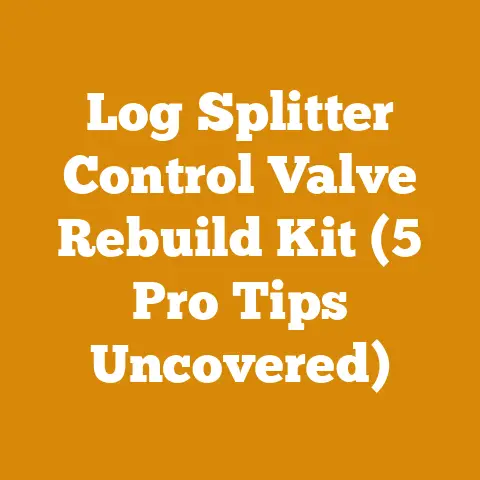Sand Blades for Mower (5 Pro Tips for Tough Soil Cutting)
Let’s talk about something that might seem mundane but can make a world of difference in your lawn care: sand blades for your mower.
We’re not just talking about any blades here; we’re talking about blades specifically designed to tackle tough soil conditions.
And yes, I know, lawn care might not seem like the most exciting topic, but trust me, once you understand the impact these blades can have, you’ll be hooked.
Sand Blades for Mower: 5 Pro Tips for Tough Soil Cutting
I’ve spent years in the yard, tinkering with every kind of blade imaginable, and I’m here to share my insights.
Understanding Sand Blades
Sand blades, often called “sandy soil blades” or “heavy-duty mower blades,” are specially engineered to withstand the abrasive conditions of sandy or tough soil.
Unlike standard mower blades, which can quickly dull or wear down in such environments, sand blades are typically made from hardened steel and feature a unique design that helps them maintain their sharpness and durability.
Why Sand Blades Matter
The primary reason to switch to sand blades is longevity.
Standard blades simply don’t hold up when constantly hitting sand, rocks, and compacted soil.
This leads to frequent replacements, costing you time and money.
Sand blades, on the other hand, are designed to last, reducing the need for constant maintenance.
I remember one summer when I was using standard blades on a particularly sandy patch of my yard.
I was replacing them almost weekly!
The frustration was immense.
That’s when I decided to invest in a set of sand blades, and the difference was night and day.
Pro Tip 1: Choosing the Right Sand Blade
Selecting the right sand blade is crucial.
Not all blades are created equal.
You need to consider several factors, including the type of mower you have, the size of your deck, and the specific soil conditions you’re dealing with.
Blade Material
Most sand blades are made from high-carbon steel or hardened alloy steel.
These materials offer excellent durability and resistance to wear.
Look for blades that are heat-treated for added strength.
- High-Carbon Steel: Offers a good balance of hardness and toughness.
- Hardened Alloy Steel: Provides superior wear resistance, ideal for extremely sandy or rocky conditions.
Blade Design
Sand blades often feature a wider cutting edge and a more aggressive angle than standard blades.
This design helps them slice through tough soil and vegetation with ease.
Some blades also have a reinforced cutting edge for added durability.
- Wider Cutting Edge: Provides more surface area for cutting, reducing wear.
- Aggressive Angle: Improves cutting performance in dense vegetation.
- Reinforced Cutting Edge: Adds extra protection against impact and abrasion.
Blade Size and Compatibility
Ensure that the sand blades you choose are the correct size for your mower deck.
Measure your current blades or consult your mower’s owner’s manual to determine the appropriate length and center hole diameter.
Also, consider the blade’s lift.
- Blade Length: Should match the original blade length for optimal cutting performance.
- Center Hole Diameter: Must match the mower spindle for secure attachment.
- Blade Lift: Affects the mower’s ability to discharge clippings.
High-lift blades are ideal for bagging, while low-lift blades are better for side-discharge.
My Experience
I learned the hard way about blade compatibility.
I once bought a set of sand blades online without checking the center hole diameter.
When they arrived, they didn’t fit my mower at all!
Always double-check the specifications before making a purchase.
Pro Tip 2: Sharpening Your Sand Blades
Even the toughest sand blades will eventually dull over time.
Sharpening your blades regularly will not only improve cutting performance but also extend their lifespan.
When to Sharpen
You should sharpen your sand blades at least once a season, or more frequently if you notice a decline in cutting performance.
Signs that your blades need sharpening include:
- Torn or ragged grass blades
- Uneven cutting height
- Mower struggling to cut through grass
- Excessive vibration
Sharpening Tools
There are several tools you can use to sharpen your sand blades, including:
- Bench Grinder: A power tool with a grinding wheel that quickly sharpens blades.
- Angle Grinder: A handheld power tool with a rotating disc that can be used for sharpening.
- File: A manual tool that requires more time and effort but provides precise control.
Sharpening Technique
- Safety First: Always wear safety glasses and gloves when sharpening blades.
- Secure the Blade: Clamp the blade in a vise to hold it securely.
- Maintain the Angle: Use the sharpening tool to grind the cutting edge at the original angle.
- Remove Burrs: Use a file or grinding wheel to remove any burrs from the cutting edge.
- Balance the Blade: Use a blade balancer to ensure that the blade is properly balanced.
An unbalanced blade can cause excessive vibration and damage to your mower.
A Word of Caution
Sharpening blades can be dangerous if not done properly.
If you’re not comfortable sharpening your own blades, consider taking them to a professional.
I remember one time when I was sharpening a blade with a bench grinder.
I got distracted and accidentally rounded off the cutting edge.
The blade was useless!
I learned my lesson that day: always focus and take your time when sharpening.
Pro Tip 3: Maintaining Your Mower Deck
Your mower deck plays a crucial role in the performance of your sand blades.
Keeping it clean and well-maintained will help your blades last longer and cut more effectively.
Cleaning the Deck
Regularly cleaning your mower deck will prevent the buildup of grass clippings, dirt, and debris.
This buildup can reduce airflow and cause your blades to dull more quickly.
- After Each Use: Scrape away any loose clippings and debris.
- Monthly: Use a pressure washer to thoroughly clean the underside of the deck.
Be sure to disconnect the spark plug wire before cleaning to prevent accidental starting.
Inspecting the Deck
Periodically inspect your mower deck for signs of damage, such as cracks, dents, or rust.
Repair any damage promptly to prevent further deterioration.
- Cracks: Can weaken the deck and affect its structural integrity.
- Dents: Can interfere with airflow and blade rotation.
- Rust: Can corrode the deck and cause it to fail.
Applying a Protective Coating
Applying a protective coating to your mower deck can help prevent rust and corrosion.
There are several products available, including:
- Rust-oleum: A popular rust-preventative paint.
- Undercoating: A rubberized coating that provides excellent protection against rust and abrasion.
- Non-Stick Sprays: Reduce grass buildup and make cleaning easier.
My Recommendation
I’ve found that regularly applying a non-stick spray to my mower deck makes a huge difference.
It prevents grass clippings from sticking, making cleanup a breeze.
Pro Tip 4: Adjusting Your Mowing Height
The height at which you mow your lawn can significantly impact the performance of your sand blades.
Mowing too low can cause the blades to hit the ground more frequently, leading to increased wear and tear.
Optimal Mowing Height
The optimal mowing height for your lawn depends on the type of grass you have.
As a general rule, you should never remove more than one-third of the grass blade in a single mowing.
- Cool-Season Grasses (e.g., Kentucky Bluegrass, Fescue): 2.5-3.5 inches
- Warm-Season Grasses (e.g., Bermuda, Zoysia): 1-2 inches
Adjusting Mowing Height
Most mowers have adjustable cutting heights.
Consult your owner’s manual to determine how to adjust the cutting height on your mower.
- Raise the Deck: For rough or uneven terrain to avoid scalping.
- Lower the Deck: For a closer cut on smooth, even lawns.
The Importance of High Mowing
Mowing at a higher height has several benefits:
- Promotes Deeper Root Growth: Taller grass blades shade the soil, reducing water evaporation and encouraging deeper root growth.
- Improves Drought Tolerance: Deeper roots help the grass withstand drought conditions.
- Reduces Weed Growth: Taller grass blades shade the soil, preventing weed seeds from germinating.
My Mistake
I used to mow my lawn very short, thinking it would save me time.
However, I quickly realized that it was actually doing more harm than good.
The grass was stressed, weeds were thriving, and my blades were wearing out much faster.
Pro Tip 5: Avoiding Obstacles
One of the best ways to extend the life of your sand blades is to avoid obstacles in your lawn.
Rocks, roots, and other debris can quickly dull or damage your blades.
Identifying Obstacles
Before mowing, take a walk around your lawn and identify any potential obstacles.
- Rocks: Remove any loose rocks from the lawn.
- Roots: Be careful when mowing near trees or shrubs with exposed roots.
- Debris: Remove any sticks, branches, or other debris from the lawn.
- Sprinkler Heads: Mark sprinkler heads to avoid hitting them with the mower.
Mowing Techniques
Use proper mowing techniques to avoid obstacles.
- Overlap Passes: Overlap each pass by a few inches to ensure that all grass is cut.
- Avoid Scalping: Raise the mower deck when mowing over uneven terrain to avoid scalping.
- Slow Down: Slow down when mowing near obstacles to give yourself more time to react.
What I Learned
I once hit a large rock with my mower, and it completely bent the blade.
I had to replace the blade and repair the mower deck.
It was a costly mistake that could have been avoided if I had been more careful.
Beyond the Basics: Advanced Tips for Tough Soil Cutting
Now that we’ve covered the basics, let’s dive into some advanced tips that can help you achieve even better results when cutting tough soil.
Soil Aeration
Aerating your soil can improve its drainage and reduce compaction, making it easier for your mower blades to cut through.
- Core Aeration: Involves removing small plugs of soil from the lawn.
- Spike Aeration: Involves poking holes in the soil with spikes.
Soil Amendment
Amending your soil with organic matter can improve its structure and fertility, making it easier for grass to grow.
- Compost: Adds nutrients and improves soil structure.
- Peat Moss: Improves water retention and aeration.
- Manure: Adds nutrients and improves soil fertility.
Overseeding
Overseeding your lawn with a grass seed that is adapted to tough soil conditions can help improve its overall health and vigor.
- Tall Fescue: A drought-tolerant grass that is well-suited for sandy soils.
- Fine Fescue: A shade-tolerant grass that is well-suited for compacted soils.
Mulching
Mulching your lawn with grass clippings can help retain moisture, suppress weeds, and add nutrients to the soil.
- Mulching Mower: A mower that chops grass clippings into fine pieces and returns them to the lawn.
- Side-Discharge Mower: A mower that discharges grass clippings to the side.
Real-World Examples and Case Studies
To illustrate the benefits of using sand blades, let’s take a look at some real-world examples and case studies.
Case Study 1: Sandy Soil
A homeowner in Florida was struggling to maintain his lawn due to the sandy soil.
He was constantly replacing his mower blades and the grass was thin and patchy.
After switching to sand blades and amending the soil with compost, his lawn began to thrive.
Case Study 2: Rocky Terrain
A landscaper in Colorado was mowing a property with rocky terrain.
His standard mower blades were wearing out quickly.
After switching to sand blades, he was able to mow the property without any issues.
Case Study 3: Compacted Soil
A homeowner in Texas was struggling to grow grass in his compacted soil.
After aerating the soil and overseeding with tall fescue, his lawn began to improve.
Common Mistakes to Avoid
Here are some common mistakes to avoid when using sand blades:
- Using the Wrong Blade: Using a standard blade in sandy or rocky conditions.
- Not Sharpening Blades: Failing to sharpen blades regularly.
- Neglecting Mower Deck: Neglecting to clean and maintain the mower deck.
- Mowing Too Low: Mowing the lawn too low.
- Ignoring Obstacles: Ignoring obstacles in the lawn.
Actionable Metrics to Measure Success
Here are some actionable metrics to measure the success of your sand blade usage:
- Blade Lifespan: Track the lifespan of your sand blades compared to standard blades.
- Cutting Performance: Monitor the quality of your cut and how well your mower performs in tough soil.
- Lawn Health: Assess the overall health and vigor of your lawn.
- Maintenance Costs: Track the cost of blade replacements and mower repairs.
Final Thoughts: Embracing the Power of Sand Blades
Switching to sand blades can significantly improve the performance of your mower and the health of your lawn, especially if you’re dealing with tough soil conditions.
By following these pro tips, you can extend the life of your blades, improve your cutting performance, and achieve a beautiful, healthy lawn.
I hope this guide has been helpful.
Remember, lawn care is an ongoing process, but with the right tools and techniques, you can achieve amazing results.
Happy mowing!






